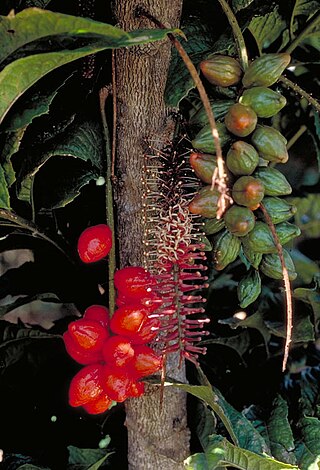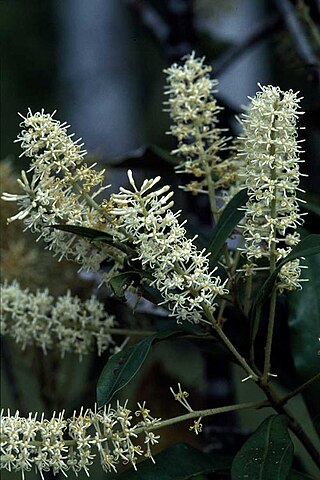
Austrobaileya is the sole genus consisting of a single species that constitutes the entire flowering plant family Austrobaileyaceae. The species Austrobaileya scandens grows naturally only in the Wet Tropics rainforests of northeastern Queensland, Australia.

Buckinghamia is a genus of only two known species of trees, belonging to the plant family Proteaceae. They are endemic to the rainforests of the wet tropics region of north eastern Queensland, Australia. The ivory curl flower, B. celsissima, is the well known, popular and widely cultivated species in gardens and parks, in eastern and southern mainland Australia, and additionally as street trees north from about Brisbane. The second species, B. ferruginiflora, was only recently described in 1988.
Beilschmiedia bancroftii is a tree species in the family Lauraceae. It is native to Queensland in Australia. Common names include yellow walnut, yellow nut and canary ash.

Hicksbeachia pilosa is a small tree in the family Proteaceae. This rare species is endemic to the rainforests of the wet tropics region of northeastern Queensland, Australia. It was first described in 1988 by Australian botanist Peter H. Weston, after a collection by Garry Sankowsky and Peter Hind in 1986 at Bobbin Bobbin Falls in North Queensland. Its specific name is the Latin adjective pilosus "hairy".

Darlingia ferruginea, commonly known as the brown silky oak, is a rainforest tree of the family Proteaceae from Northern Queensland.
Neorites is a monotypic genus of plants in the family Proteaceae. The sole species Neorites kevedianus, commonly called fishtail oak or fishtail silky oak, is a tall tree endemic to the wet tropics rainforests of north eastern Queensland, Australia.
Hollandaea is a small genus of plants in the family Proteaceae containing four species of Australian rainforest trees. All four species are endemic to restricted areas of the Wet Tropics of northeast Queensland.

Placospermum is a genus of a single species of large trees, constituting part of the plant family Proteaceae. The species Placospermum coriaceum is endemic to the rainforests of the wet tropics region of northeastern Queensland, Australia. Common names include rose silky oak and plate-seeded oak.

Catalepidia is a monotypic genus in the family Proteaceae which is endemic to Queensland, Australia. The sole described species is Catalepidia heyana, commonly known as Hey's nut oak. It is a medium sized tree growing up to about 18 m (59 ft) tall, and is found only in upland rainforest above 600 m (2,000 ft) on granite soils, ranging from the Windsor Tableland to the Atherton Tableland.
Sphalmium is a monotypic genus of flowering plants in the protea family. The only species, Sphalmium racemosum, is a large forest tree. Common names include satin silky oak, mystery oak, Mt Lewis oak, poorman's fishtail oak and buff silky oak.

Nothorites is a monotypic genus in the macadamia family Proteaceae. The sole species, Nothorites megacarpus, is endemic to the wet tropics rain forests of northeastern Queensland, Australia.

Lasjia is a genus of five species of trees of the family Proteaceae. Three species grow naturally in northeastern Queensland, Australia and two species in Sulawesi, Indonesia. Descriptively they are the tropical or northern macadamia trees group. Lasjia species characteristically branched compound inflorescences differentiate them from the Macadamia species, of Australia, which have characteristically unbranched compound inflorescences and only grow naturally about 1,000 km (620 mi) further to the south, in southern and central eastern Queensland and in northeastern New South Wales.
Helicia lewisensis is a species of rainforest trees, of northeastern Queensland, Australia, from the flowering plant family Proteaceae. It is endemic to the northern upland rainforests of the Wet Tropics region, from about 900 to 1,330 m altitude.
Helicia lamingtoniana, also named Lamington's silky oak, is a species of rainforest trees, of northeastern Queensland, Australia, from the flowering plant family Proteaceae.
Helicia blakei, also named Blake's silky oak, is a species of rainforest tree, of northeastern Queensland, Australia, from the flowering plant family Proteaceae.
Hollandaea sayeriana, sometimes named Sayer's silky oak, is a small species of Australian rainforest trees in the plant family Proteaceae.
Hollandaea riparia, sometimes named roaring Meg hollandaea, is a species of Australian rainforest tree, in the plant family Proteaceae.
Hollandaea diabolica is a species of Australian rainforest tree, constituting part of the plant family Proteaceae. It is endemic to restricted areas of the rainforests of the Wet Tropics region of northeastern Queensland.
Hollandaea porphyrocarpa is a species of small Australian rainforest tree in the plant family Proteaceae. It is endemic to restricted areas of the rainforests of the Wet Tropics region of northeastern Queensland.
Austromuellera valida is a species of rainforest tree in the protea family that is endemic to north-eastern Queensland, Australia. It was first formally described by Bernard Hyland in 1999 in the series Flora of Australia.








